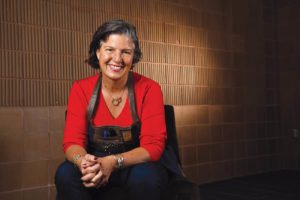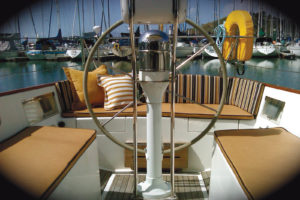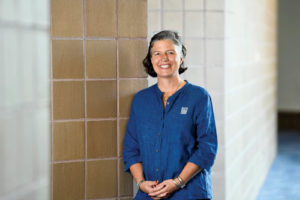 Having a really good life is not financially driven. It’s inspiration driven,” says Liz Diaz, MFC, owner of North Beach Marine Canvas in San Francisco, Calif. “Working on and around the water is a singularly lovely employment. I am inspired all the time by my location, by the San Francisco Design Center, by my tools of the trade—and by the camaraderie I find with longstanding friendships with other industry and IFAI members. Success is a byproduct of doing what you like to do.”
Having a really good life is not financially driven. It’s inspiration driven,” says Liz Diaz, MFC, owner of North Beach Marine Canvas in San Francisco, Calif. “Working on and around the water is a singularly lovely employment. I am inspired all the time by my location, by the San Francisco Design Center, by my tools of the trade—and by the camaraderie I find with longstanding friendships with other industry and IFAI members. Success is a byproduct of doing what you like to do.”
Diaz discovered a way to combine her love for boats with pursuing an inspired vocation in the 1980s—after studying in Yugoslavia (now Croatia) and then returning to her home in Portland, Ore., to set off with friends on a sailing trip around the world. “While I was in Yugoslavia I met a friend in Dubrovnik who had a sewing shop in the bustling center of Zagreb. The shop was next to restaurants and cafes and she and her mother made quilts. I thought it was such a cool way to live, and I gained a new perspective on the meaning of ‘quality of life.’ I was impressed and inspired by her work, and I knew I would one day be self-employed.”
The subsequent sailing trip seemingly came out of nowhere—Diaz had little sailing experience when friends invited her to join them on their world sailing excursion. “I had just graduated from Portland State University and had no immediate plans
so I said: Why not?” she says.
By 1986, Diaz had settled in San Francisco, bought a 1956 Japanese-built wooden sailboat named Kaze (the Japanese word for “wind”), and started sewing marine canvas on a sewing machine in her dining room.
She set up shop in San Francisco’s North Beach and began honing her skills in earnest—which meant learning everything she could about the marine canvas and interiors industry so she could pursue her Master Fabric Craftsman (MFC) certification from IFAI. “Early on I went to IFAI Expo and met people like Mike Erickson [MFC], Katie Bradford [MFC and IFM (Industrial Fabric Manager)] and Bob Cole [now LHM (Lifetime Honored Member)], and felt immediately supported,” she says. “I also found out that you needed to work as a fabricator for at least five years before you could apply for your MFC—so I took that to heart. I applied myself and after five years went back and got my MFC. I’m proud of that.”
 A great escape
A great escape
What Diaz does for her clients is nothing short of bringing their dreams to life. “I don’t just make boat cushions—I transform the space,” Diaz says. “I like to think of myself as a life stylist. I take the space in a boat and make it resonate with who the owners are and how they use their boats by helping them make an experience out of being on their boat—it’s about more than just taking the boat out somewhere. The boat is the destination.”
While Diaz asks questions of her clients about how they use their boats, and offers input on the process and options based on her experience and expertise—she doesn’t want to know what they do for a living. “In most cases we’re creating a separate universe for them,” she says. “I don’t want what my clients do for a living to color what we’re doing here.”
Diaz’s approach to her business aligns with her high standards and her inspiration-driven life. She chooses to subcontract craftspeople instead of hiring employees. “I’ve learned that I like to have the work done by people who specialize in what they do and work independently,” she says. “When I call them, they get right on it, and I pay immediately. I’m an excellent customer and they are excellent craftspeople.”
 In other shoes
In other shoes
This past year Diaz spent quite a bit of time on the other side of the client/fabricator relationship—restoring her wooden sailboat Kaze. “Last year the keel almost fell off and she almost sank,” she says. “So I chose to bite the bullet and invest in her. I felt like I was getting the same kind of attention that I give my customers when I build a boat interior for someone. It was one of the greatest experiences I’ve had recently—to work with specialists/craftspeople in a boatyard that only works with wooden boats.”
Always on the lookout for ways to improve her business, Diaz has been taking continuing education classes, which focus on helping people bring their passions and talents together to create a positive impact. As a result, she is developing a product to provide housing for some of San Francisco’s homeless—a single-owner occupied fabric-covered tiny house. “There are more than 7,000 homeless people in San Francisco, and I think it’s our duty to try to find a way to provide housing for them. The city already spends quite a bit of money dealing with the issue,” she adds.
“Canvas Houses” is a project that Diaz is passionate about—and she’s moving at lightning speed to bring it to fruition. She hopes to have a finished prototype and a partnership with the city of San Francisco in the next few months. “Obviously the homeless problem is a complex issue, but these canvas houses can help solve the housing portion for some individuals,” she says. “Since 1912 when a group of canvas manufacturers formed the National Tent & Awning Association [now IFAI], the specialty fabrics industry has organized to use fabric to provide for people’s needs.
It still does that today. And that is a legacy.
The Hinckley Company builds only 50 yachts each year, custom-ordered from stem to stern. So when clients wanted all the soft surfaces of their Hinckley sailing yacht reupholstered—from V-berth to cockpit—they wanted a marine fabricator that could
do its origin justice. “I was privileged to work with these clients to design this project,” says Liz Diaz. “They wanted the boat to be a complete expression of their appreciation of beauty and craftsmanship.”
The clients embraced the vision Diaz presented them in the version of sketches,
based on what they told her about how they used their boat, and what they hoped it could be. The project ultimately included 19 different fabrics and leathers mostly in shades of black and gold. “The covering on the right side of the dinette was different than that on the left side of the dinette—leather over here; soft fabric over there,”
Diaz says. “The project included channel quilting and flanges. It was stunning.
It reflected the clients’ dreams that they didn’t previously know were possible.”
What is your vision for the Canvas Houses project you’re working on?
I am bringing all my experiences to bear for this project: my experiences with IFAI, my experience with technical fabrics and design and building, and my dedication to contributing to a solution for people who need homes. The buildings will incorporate solar panels, infrared heating, a composting toilet system and a dinette that converts into a bed. Right now we’re in conversation with the city to find ancillary property in San Francisco to locate the structures. The concept includes a tightly designed interior that incorporates marine space-saving elements, and heightens the aesthetic of the houses by embracing the unlimited potential of surface design—using them as an artistic canvas. These houses can be a fusion of purpose, inspiration and vision for the people who live in them, as well as for the rest of the community.
 TEXTILES.ORG
TEXTILES.ORG



Liz Diaz, this article has struck a cord with my heart! It helps direct my focus towards helping resolve the same problem San Diego is facing with homeless people. I would welcome the opportunity to talk and work with you. Mike Gavin, Canvas Services; San Diego, CA